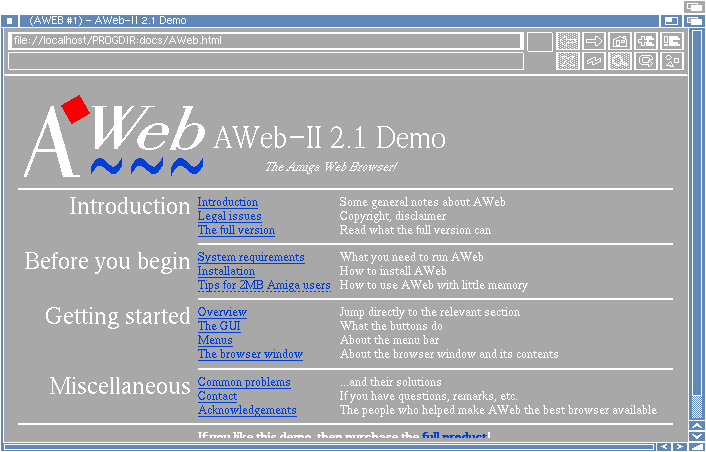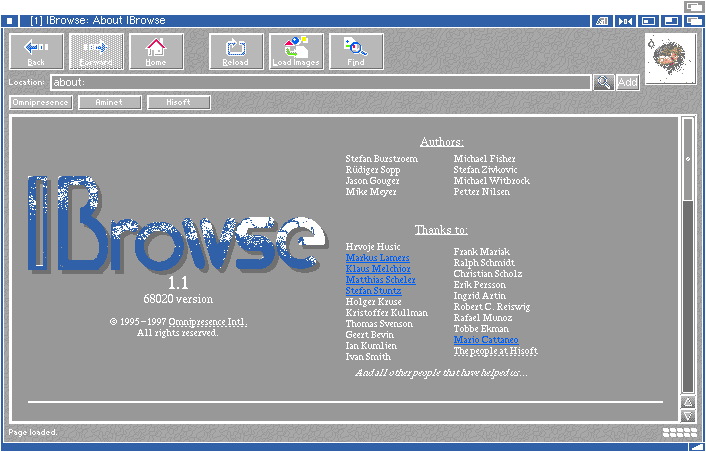There was a time, not too many years ago, when many Amiga users had to wonder if their computers could dream of keeping up with PC's and Macintoshes in the new, emerging world of the Internet. Graphical Internet connections were soon all the rage, and Mosaic paved new pathways along with the newly developing World Wide Web.
Amiga programmers had an answer, however, in the form of AMosaic, a graphical browser capable of using AmiTCP which, albeit difficult to configure and understand, was effective. While seemingly remarkable at the time, in retrospect, AMosaic was quite simplistic. It could render different font sizes and styles, and display images, but that was about it.
Well within the last two years, three major Amiga-native browsers (as opposed to AMosaic, which was a port of the original Mosaic) have been developed and introduced. IBrowse, Voyager, and AWeb have all brought significant improvements over AMosaic, and make almost any Amiga with a hard disk and some extra memory fully Web-capable.
In this "Feature Review," if you will, I will be looking at the latest versions of these three browsers. I would like to say, first off, that I am by no means an expert at this type of software; I am simply another Amiga user who uses such programs from day to day. I will be conducting this review in that context; it will simply be a look at some of the more "user-accessible" aspects of the browsers, or outside impressions and features, and what any user is likely to encounter on any given day.
Also, after reading about this upcoming article in the last issue of AM, a reader wrote in and suggested that I also investigate the various TCP stacks available for the Amiga, in connection with IBrowse, Voyager, and AWeb-II. While I would like to do this, the method of charging on my CompuServe account makes this financially impractical. If I can borrow access to somebody's ISP account, I may be able to do this in the future, but for now, it's just the browsers "revving their engines in the garage."
For this review, I am using the latest (as of this writing) demos of Voyager NG (Next Generation) and AWeb-II. I went ahead and bought IBrowse, so I'm using the full commercial version of that. However, I will endeavor to point out which features are unique to the commercial version so as to avoid any confusion.
I will now discuss each browser, in sequence.

Voyager is brought to you by Oliver Wagner and VaporWare. It was first introduced about a year ago in the form of the freeware Voyager 1.0. At the time, it looked to have a good deal of potential, although it soon gave way to IBrowse's superior HTML capabilities. However, in the time after it was introduced, it developed a strong following, making its way in some form into the Amiga Surfer package.
Not a group to do things gradually, the Voyager team released Voyager NG (Next Generation) a bit over a month ago. This new release dramatically updated the browser's capabilities, not only to include the wonderfully useful Tables, but also to be the first Amiga web browser to support Frames, a feature conspicuously missing from the lot before then.
Voyager, like so many others like it, uses MUI, and therefore includes the excellent configurabilty and quality of user interface that MUI generally denotes. Voyager strays a bit from the Amiga User Interface Style Guide, particularly in the layout of the menus, but it's not difficult to learn and use.
In many other ways, Voyager is "typical web browser"; it has a strip of navigation buttons across the top, some link buttons, a URL gadget, transfer animation (an interesting one, if I may say so), scroll bars, etc. Beyond those, and some other fundamentals, your relative impressions of Voyager and the others are largely going to come down to personal taste.
What's missing? Well, Voyager's tables are a bit unorthodox, which would be fine, but it did some poor rendering of some of AM's table code which, as far as I know, is perfectly HTML-legal. The errors are visually rather severe in some cases, and a number of the problems seem to be associated with nested tables. This is an area that definitely needs to be addressed.
It is notable that unlike the other two, Voyager supports e-mail links, and multiple windows, in its demo form.
All things considered, Voyager NG is a huge leap from the first release, and it shall be interesting to see where it goes from here.

At first glance, AWeb stands out in the field of Amiga web browsers for one reason: it does not use MUI. When most Amiga Internet software seems to use MUI almost as a matter of course, AWeb boldly defies this idea and uses a more custom GUI, based on the ClassAct GUI system.
AWeb also appeared more or less within the last year, and made a splash in the beginning. There are, after all, good reasons not to use MUI, ranging from speed to system resource use. The author of AWeb gave a rather lengthy explanation of exactly why this was done in the first version.
The first AWeb was rather simplistic, with the inability to align HTML entities anywhere but the left side. It was a bit bare in other ways, also. Of course, not to be outdone by the competition, AWeb has now become AWeb-II, and sports a wide range of improvements including alignments, tables, and a primitive recognition of Frames that at least shows you the structure of a Framed page.
On the subjective side, I like AWeb's mission to avoid MUI (in my opinion, it is good if there are both MUI and non-MUI products within a general category, as both offer advantages), but its GUI is a bit spartan otherwise. It's easy to believe, after viewing enough examples, that the Amiga is somehow incapable of colorful, complex GUI's without MUI. That just isn't the case. I, for one, would like to see AWeb with a somewhat enhanced user interface.
The hierarchy of the program is very thorough and, overall, easy to use. It performs well, and can be used easily on systems with relatively low-end specifications. All things considered, it is clearly a significant member of the constantly evolving group of Amiga Internet applications.

I believe it is safe to say that IBrowse has been the king of Amiga web browsers for the last year or so. This is not to disparage any others; simply, Omnipresence's IBrowse has been in constant development since its introduction, with updates released more or less monthly. The others just sat still, although now, they have leveled the playing field somewhat. However, IBrowse has been the frontrunner right along, which is why, as you may notice, AM is said to be optimized for it.
IBrowse was the direct successor for AMosaic, which gave it somewhat of an edge right from the start. It was the first Amiga browser, if memory serves, to support Tables. The first commercial version became available a number of months ago, and it has been updated to 1.02 and 1.10 since then.
VaporWare upstaged Omnipresence somewhat with its introduction of the vastly improved Voyager-NG in February, but IBrowse proved to be right on its heels, with version 1.10 recently giving IBrowse Frames as well.
The update provides a whole list of improvements and new features. Perhaps most notable are, of course, the Frames, as well as improved performance and image dithering routines. It also includes a string gadget that supports drag-select and clipboard cut and paste, something the Amiga should have had long ago.
IBrowse renders tables very well, and although I haven't had much of a chance to test it yet, the Frames support appears good. On a more subjective note, this is still my personal favorite web browser, despite recent developments. Beyond that, however, it's often a matter of personal preference, as to the look and feel and general operation, etc. IBrowse is, still, a very competent and capable web browser.
Voyager-NG, AWeb-II, and IBrowse are all very well-done and capable pieces of software, and as I have said, your choice of one over the other would probably fall upon personal tastes and system specifications. However, there are certain things to note when choosing which, if any, of these will be your primary web browser.
I said I couldn't discuss TCP Stacks because I don't use them enough on the Amiga, but I can give a little background information based on shared information, and experiences. I have used all three major TCP options for the Amiga that most people use these days (AmiTCP, Miami, TermiteTCP), and all work quite well (once configured...easier said than done for the Internet newbie I was at the time with AmiTCP). However, there are some things to remember when matching clients with TCP stacks.
Netscape has been essentially the last word on browsers for the PC and Mac for several years now (and still is, despite the threatened encroachment of Microsoft Internet Explorer). Naturally, then, we might compare current Amiga browsers to Netscape to see how we're doing, or to look at where we have to go from here.
In my opinion, all the Amiga browsers already have an edge on Netscape due simply to the Amiga OS's supreme ease of use (not to mention coherent design). As GUI's to the Internet, they often call upon many of a computer's faculties, and it shows. However, there are some areas in which the Amiga browsers are still somewhat deficient compared to Netscape, or anything like it.
There are other features/details Netscape provides that may prove useful to Amiga browsers, but I'm going to leave it at this for now.
There really isn't a long list, however. One must decide this for oneself, but I personally believe the Amiga browsers, as a whole, are on an overall par with Netscape, all things considered.
Again, this review probably isn't as informative as it could have been had I more time and better resources for performing tests and comparisons. However, the goal was to provide a comparative profile of the various web browsers available for the Amiga, from the point of view of somebody who uses such software every day.
The development of Amiga Internet software from the primordial to the present has been fascinating to watch. All three of these browsers have come a long way, and each has its respective advantages and disadvantages. In any event, you must only look at what each gives you, and how, and decide which is best for your needs. Fortunately, they are all available in demo form, so you can test them all simultaneously without spending a cent if you so choose. The choice is yours, and the choices are good ones at that.
You can find information on Voyager at www.vapor.com, AWeb-II at www.amitrix.com, and IBrowse at www.omnipresence.com.